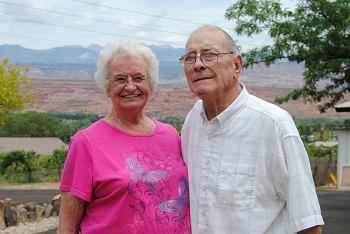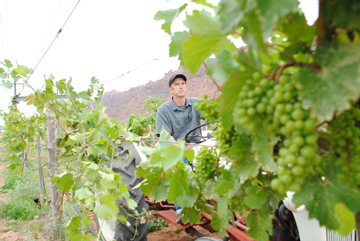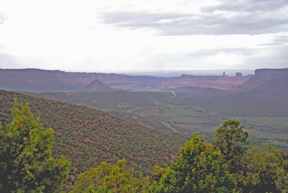“Move Over Napa Valley!”
recalls lifelong Moab resident Arlis Roberts. “You couldn’t believe the excitement.” It was the early 1980s and the first four years of the Four-Corners Agricultural Development Agency of Moab. Vineyards sprouted up all over Grand County. The agency hoped to soften the blow of the uranium mill closure on the 1,500-resident town. Ken and Arlis Roberts were one of thirty families who started growing wine grapes.“It was easy money,” adds Ken, “The state was giving it away, so I read a couple of books and gave it a shot.”
Ken is now eighty-years old. His large leathery hands are defined by the lifetime spent as a farmer and mill worker. Ken took up viticulture at the age of forty-seven, more for “fun money” than out of necessity. It also was a family activity. The grandchildren helped by putting a fertilizer tablet into the ground beside each of the vines on nearly four acres.
Hard Work Pays off for these Viticulturists
The Roberts were one of the few who stuck with it and eventually succeeded. Arlis recounts how, after thirteen years, Ken decided to use their grape-harvest money to pay cash for a new Ford truck. When she asked, “I thought this was supposed to be used as our fun money.” Ken replied, “Yea, isn’t this fun?”
Thirty vineyards dotted the Moab landscape in the early 1980s. The Roberts’ four acres are the last remaining of those that were started. “Most residents didn’t realize the extent of the hard work involved. They thought they could just pick the grapes with one hand and put the money in their pocket with the other,” says Arlis.

The test plots proved that Moab has favorable conditions for growing wine grapes. The sandy loam is ideal. The cold desert evenings are also excellent for providing the sufficient stress required to produce unique flavor nuances. But few farmers had the know-how of proper pruning techniques and long-term care of grape vines. And it turned out, Napa Valley wineries didn’t line up to buy the grapes grown by Moab farmers.

Working together, Arlis and Ken planted 2,800 grapevines ranging from Cabernet grapes to Petite Sirah. They worked together for four months in the evenings after work digging holes and pounding cedar posts into the ground so that each vine could be trained along wires. They did the job right. At peak production, the Roberts harvested 19 tons of grapes, and up until just a few years ago, they were receiving big paychecks from a relatively new operation in town: Castle Creek Winery at the Red Cliffs Lodge.
Well-tended vines can produce for decades. This is good news for Will Fryer, Castle Creek’s head vintner, who has been learning the business for the past seven years. Fryer planned to grow his own wine grapes on the banks of the Colorado River at Red Cliffs Lodge. However, the soil conditions and extremely hard water made the endeavor nearly impossible to achieve, so Fryer has managed to continue to produce his award winning wine by relying on the Roberts’ hard work. Fryer purchased the Roberts’ vineyards and has hired a full-time viticulturist, Mary. Beginning this year, a large percentage of the grapes they use will come from Utah. Fryer expects that in the next few years, the vines will again reach their peak and again produce close to 20 tons. Castle Creek wine is having a hard time keeping up with demand, and the awards are rolling in by the barrelful. They are currently bottling 14,000 gallons of wine per year, they expect to be up to 20,000 gallons within the next year.






